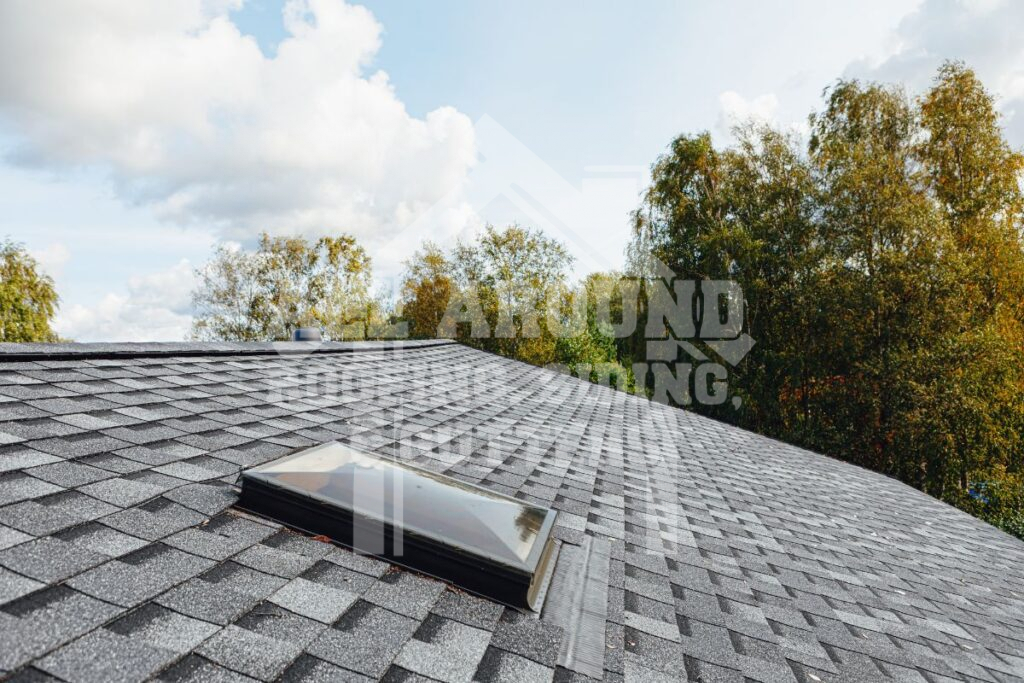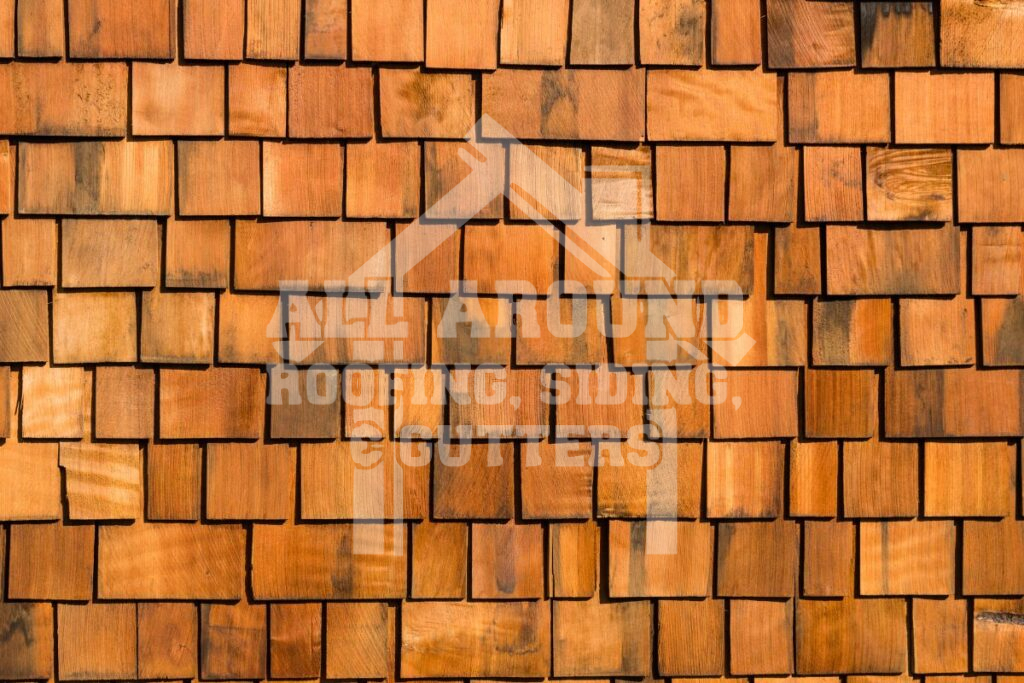The intense summer sun in Dayton can make your roof extremely hot. On a hot day, it might reach over 150 degrees, which is hot enough to fry an egg! This intense heat can affect your home, raise your energy bills, and shorten the lifespan of your roofing materials.
In this blog post, we will answer the question “How hot does a roof get in the summer?”, look at the temperature ranges for different roofing materials, and discuss the effects of high roof temperatures.
How Hot Do Different Roof Types Get?
#1. Asphalt Shingles

A popular and affordable roofing material, asphalt shingles absorb and retain heat more than other materials. Made from a blend of asphalt, fiberglass, and mineral granules, their dark color makes them especially hot, reaching up to 160 degrees on a sunny day. This heat can increase cooling costs and cause the shingles to age and deteriorate faster, requiring frequent replacements.
#2. Metal Roofs

A durable and energy-efficient option, metal roofs get hot but not as much as asphalt shingles, usually around 140 degrees. Their reflective, light-colored, or coated surfaces bounce back sunlight, making them cooler. Their ability to quickly dissipate heat helps regulate building temperatures and reduce energy costs.
#3. Tile Roofs

Tile roofs, made of clay or concrete, are also cooler than asphalt shingles. Their surface temperature ranges from 120 to 140 degrees. Tiles have natural insulating properties and slowly absorb and release heat.
Clay tiles, in particular, reflect more sunlight due to their light color and porous nature. Concrete tiles also help regulate roof temperature with their higher thermal mass.
#4. Wood Shakes

Another commonly used option, wood shakes, made from split logs, can reach 160 degrees or higher. Their organic composition absorbs and retains heat, leading to higher cooling costs and faster weathering and degradation. Wood shakes lack the reflective or insulating properties of metal or tile roofs, making them less effective at keeping buildings cool.
#5. Flat Roofs
| ROOF TYPE | TEMP. RANGE | CHARACTERISTICS |
| Modified Bitumen | Over 180 degrees | Dark color, bitumen composition, absorbs solar radiation |
| EPDM (Ethylene Propylene Diene Monomer) | 140-160 degrees | Often dark color but available in light, synthetic rubber, reflects sunlight, less heat absorption |
| TPO (Thermoplastic Polyolefin) | 120-140 degrees | Light color, thermoplastic material, highly reflective, heat resistant |
| Built-Up Roof (BUR) | 160-180 degrees | Layers of bitumen and fabrics, dark color, significant heat absorption |
Also Read: 5 Popular Flat Roof Types In 2024
What Factors Influence Roof Temperature?
1. Roofing Material
The first major factor influencing roof temperature is the thermal properties of the roofing materials in your home. For example, darker options like asphalt shingles absorb and retain heat, increasing the roof temperature.
In contrast, lighter metal roofs reflect heat, keeping the roof cooler. Clay tiles and slate also help regulate temperature due to their unique insulating properties.
2. Roof Angle
Next is the angle or pitch of the roof. Steeper roofs get hotter because they receive more direct sunlight throughout the day. While flatter roofs may get less intense direct heat, they can still build up significant temperatures.
3. Location and Climate
Geographical location and climate are crucial factors in determining roof temperature. Latitude, climate, and altitude influence solar radiation absorption. Buildings near the equator, in hot, dry climates, and at lower altitudes generally experience higher temperatures.
Roofs in hotter, sunnier climates become much hotter than those in cooler regions. For instance, roofs in Dayton, OH, are cooler in summer than in Phoenix, AZ, where extreme heat is common.
4. Time of Day and Season
The time of day and season significantly impact roof temperature. Roofs peak around midday when the sun is overhead, and summer months are generally hotter than winter. Roof temperatures fluctuate, peaking in the mid-to-late afternoon and cooling significantly overnight before heating up again the next day.
5. Color of the Roof
Roof color affects heat absorption and reflection. Light-colored roofs, like white or light gray, reflect more sunlight, keeping the roof cooler. In contrast, dark-colored roofs, such as black or dark brown, absorb more heat, leading to higher temperatures.
6. Urban Heat Island Effect
The urban heat island effect makes cities significantly warmer than surrounding rural areas due to heat-absorbing surfaces like rooftops, roads, and buildings. This effect can exacerbate roof temperatures in urban areas.
Dark surfaces absorb and retain heat, while rural areas with more vegetation and green spaces stay cooler.
Ways to Reduce Roof Temperature
1. Improve Attic Insulation and Ventilation
Proper attic insulation and roof ventilation prevent heat from entering your home and help expel hot air, easing the load on your air conditioning system and improving overall cooling efficiency.
2. Cool Roofing Options
Applying specialized cool roof coatings to existing roofs can enhance reflectivity. These coatings reduce heat absorption into roofing materials, improving thermal performance and energy efficiency.
3. Choose Reflective Roofing Materials
Opt for lighter or reflective roofing materials like metal, tile, or cool roof options to reduce heat absorption into your home, cutting cooling costs significantly compared to darker roofs.
4. Plant Trees for Shade
Strategically placing trees around your home blocks direct sunlight, keeping your roof cooler and reducing heat absorption. This also helps to cool your neighborhood and combat the urban heat island effect.
5. Consider a White Roof
Opt for a highly reflective white roof to dramatically reduce heat absorption by up to 80% compared to dark roofs, leading to significant energy savings and improved indoor comfort.
6. Install a Green Roof
Installing a vegetated roof reduces heat absorption, provides insulation benefits, and helps mitigate urban heat island effects, lowering energy use and greenhouse gas emissions.
What Are The Consequences Of Excessive Roof Heat?
1. Thermal Expansion and Contraction
Roofing materials expand in sunlight and contract in cooler temperatures, leading to structural weaknesses and potential water leaks.
2. Asphalt Shingle Vulnerability
High temperatures can make asphalt shingles brittle and prone to cracking by depleting their natural oils, reducing their lifespan and water resistance.
3. Flat Roof Membrane Degradation
Excessive heat can cause plasticizers in flat roofing membranes to evaporate, making them rigid and susceptible to tearing or puncturing.
4. Energy Costs and Efficiency
Intense sunlight can increase indoor temperatures, requiring more air conditioning and raising energy bills for property owners.
5. Roof Longevity
Prolonged exposure to heat can shorten a roof’s lifespan, requiring earlier repairs or replacement.
6. Financial Impact
Repairing heat-related roof damage and higher cooling costs can be financially burdensome for homeowners.
Common Heat Threats For Your Home’s Roof
1. Thermal Expansion and Contraction
As mentioned above, roofing materials expand and contract with temperature changes. This repetitive cycle can cause cracks, warping, and loosening of materials over time.
2. Heat Buildup and Radiation
Dark-colored roofing materials like modified bitumen can reach temperatures over 160 degrees even when it’s around 100 degrees outside. This heat buildup degrades the roof and poses health risks to workers, such as heat-related illnesses.
3. UV Damage and Weathering
Continuous exposure to sunlight and UV radiation can deteriorate roofing materials, causing them to fade, become brittle, and be more susceptible to cracks and peeling.
4. Moisture and Water Damage
Heat can worsen existing roof damage, making it more prone to water seepage during rainstorms. This moisture intrusion can weaken the roof structure and potentially damage the home’s interior.
Conclusion
Now you know how essential your roof is for managing your home’s temperature, especially in summer. Factors like roofing materials, colors, and ventilation affect heat retention. By making proper decisions in these areas, you can lower your roof’s temperature, improve comfort, cut energy costs, and extend its lifespan, ensuring both immediate comfort and long-term value for your home.
For the best roofing services in Dayton, OH, and the surrounding areas, choose All Around Roofing, Siding & Gutters. We specialize in high-quality roofing solutions that improve the durability, energy efficiency, and aesthetic appeal of your home. Trust our experienced team to provide quick, professional roofing services tailored to your requirements. Call us at (937) 902-2839 today.


